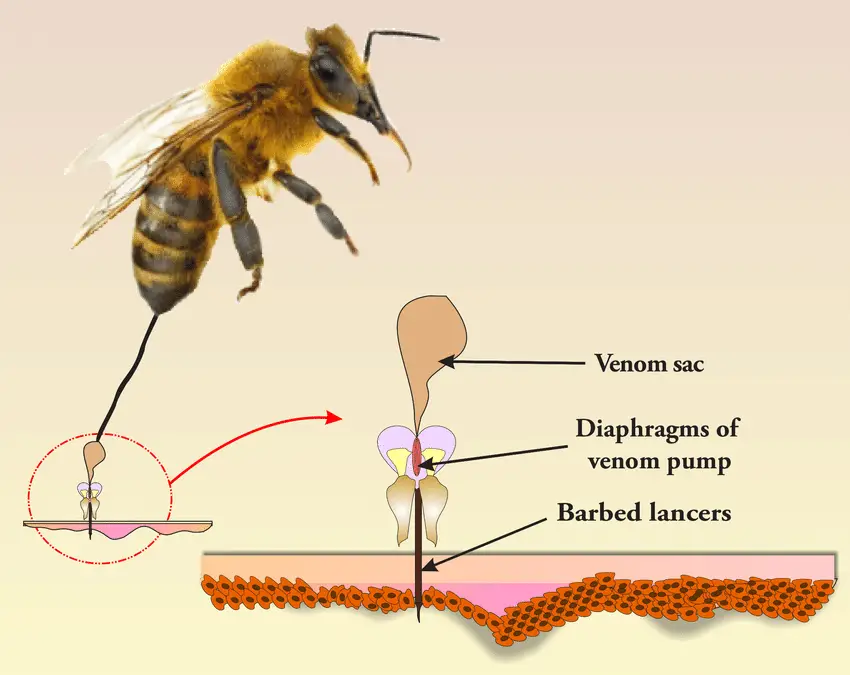I was nearly 11 years old when I remember my family getting ready for a picnic, and I brought firewood to the store with my uncle. At the very least, we couldn’t expect well-placed beehives atop piles of wooden logs.
Yes! As you can imagine, I was wearing jeans and my thigh was stung by 7 of her wasps.
So what’s the moral of the story?
Bees can definitely sting your jeans!
But let’s find out how and why….
The difference between the length of the needle and the thickness of the jeans is only 0.049 inches, making it very easy for the bee’s stinger to penetrate the material. The Stinger’s construction also allows it to cut through any heavy object with a penetrating force that continues to increase with the depth of the substrate.
Structure of a bee sting
The structure of a bee sting, also called a stinger, is divided into three parts: one stylet and two lancets. The spines are straight in appearance, with a bulbous base, tapering tip, and a narrow center about 86um in diameter.
The lancet has a barbed tapering tip, and the venom is stored in the base bulb of the needle and carried through a hollow tube.
As shown by the permeation extraction test of https://www.ncbi.nlm.nih.gov/pmc/articles/PMC4571097/ The force required for a bee sting to penetrate a surface is called the sting force.
The penetrating force of the bee sting through silica gel was 7–8 nM. The greater the force exerted by the bee sting, the greater the depth of insertion. Penetration always increases with depth, so the needle can pierce any material.

Can a bee sting penetrate through your jeans?
A typical bee sting length is 0.064 +/- 0.0007 inches, and an average weight of 12 ounces of jeans is 0.015 inches.
Therefore, it is clear that the bee’s stinger penetrates the fabric of jeans.
However, if you’re wearing baggy jeans that make minimal contact with your body, you might get lucky and save yourself from being stung.
The above experiments show that the force required for the stinger to penetrate silica gel is 7-8 mN, whereas the penetration force required for the stinger to penetrate the skin is only 2-3 mN. I’m here.
And when the pricked needle pierces the skin with the slightest contact, the venom is instantly transmitted to the body, causing immense pain and a rash on certain parts of the skin.
The amount and composition of the venom varies among bee species, but even the smallest, least toxic venom is enough to make a bee scream in pain.
When do bees sting?
Before we go any further, let’s first understand what happens when a bee stings you.
Bees only sting you when they think and realize their last option for survival – their life or their hive – is under threat.
Situations that make bees feel threatened are when you try to disturb the hive or attack them thinking they are targeting you to sting.
When a bee is dying from your attack or after stinging you, it releases pheromones as an indicator to friends attacking you so that the rest of the tribe can be saved.
How to avoid being stung by bees
Now you know why bees are stinging you.
So the best option to avoid such situations is to not mess with them. If you see bees flying around you, don’t throw attacks at them.
Use fire as a defensive measure when going near a beehive. Fire smoke obscures vision and prevents communication with others.
What kind of clothing protects against bee stings?
You should wear very sturdy and thick clothing to avoid being stung by bees. The thickest materials include thick jeans, leather, and PU-coated clothing.
Therefore, if you go near beehives, protect yourself with the following clothing:
-
-
- bee protective coveralls
- A glass face mask that is a helmet with a glass shield that protects the eyes and head together
- puncture resistant gloves
- leather shoe rubber
- Loose clothing that maximizes the distance from the skin to the garment
-
And rap!
It’s the nature of the earth, and so are all the creatures that live on it, to grow back when damaged.
Bees will not sting you unless you intend to disturb their habitat or harm them. You risk being bitten by it only when it feels threatened by you.
So if you plan to trek in the woods where you may encounter bees, follow the tips above to stay protected.Prevention is better than cure.


